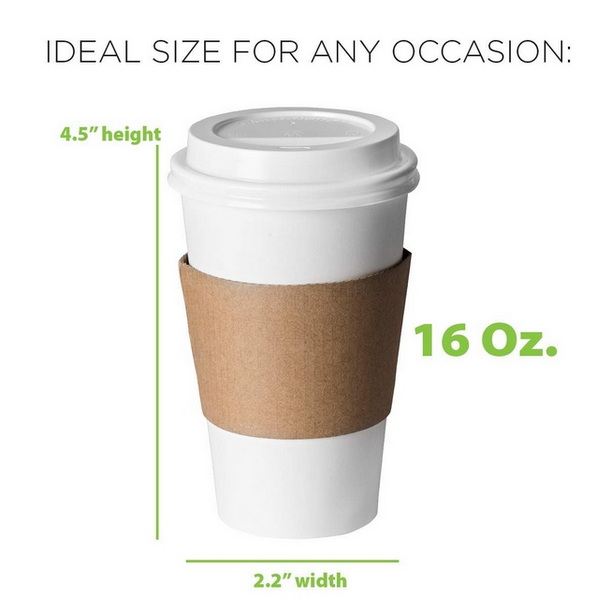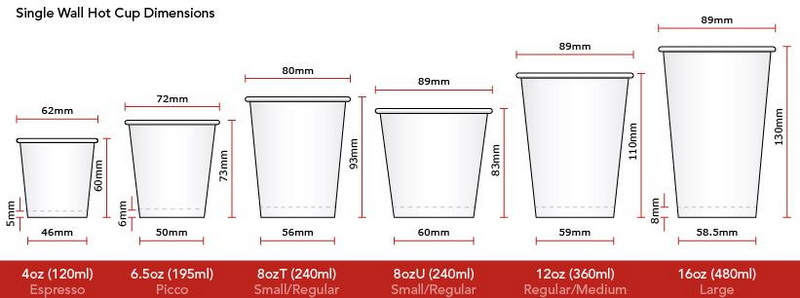
Content Menu
● 1. Common Sizes of Disposable Coffee Cups
● 2. Understanding Cup Widths
● 3. Materials Used in Disposable Coffee Cups
● 4. Environmental Impact of Disposable Coffee Cups
>> The Scale of Usage
>> Carbon Footprint
● 5. Innovations in Disposable Cup Design
>> Historical Context
● 6. Sustainable Alternatives
● 7. Conclusion
● FAQ
>> 1. What is the most common size of disposable coffee cup?
>> 2. Why are disposable coffee cups not recyclable?
>> 3. How long does it take for a disposable coffee cup to decompose?
>> 4. What materials are used in disposable coffee cups?
>> 5. Are there eco-friendly alternatives to traditional disposable coffee cups?
● Citations:
Disposable coffee cups have become an integral part of our daily routines, especially for those who enjoy their coffee on the go. Understanding the dimensions of these cups, particularly their average widths, is essential for both consumers and businesses. This article will explore various aspects of disposable coffee cups, including their sizes, materials, environmental impact, innovations in design, and more.

1. Common Sizes of Disposable Coffee Cups
Disposable coffee cups are available in various sizes, each designed to cater to different beverage volumes and consumer preferences. The most common sizes include:
- 4 oz: Typically used for espresso shots or tasting samples.
- 8 oz: Often referred to as the "Short" size in many coffee shops, ideal for small hot beverages.
- 12 oz: Known as the "Tall" size, this is a popular choice for a standard-sized coffee.
- 16 oz: Commonly called the "Grande" size, perfect for larger servings.
- 20 oz: Often used for iced coffees or larger cold beverages.
The average widths of these cups can vary slightly based on the manufacturer and design. However, here are the typical top diameters:
| Size | Top Diameter (mm) | Height (mm) |
| 4 oz | 61 | 65 |
| 8 oz | 80 | 90 |
| 12 oz | 90 | 110 |
| 16 oz | 90 | 137 |
| 20 oz | 90 | 152 |
As observed, the 8 oz cup has a top diameter of 80 mm, while both the 12 oz and 16 oz cups share a diameter of 90 mm.
2. Understanding Cup Widths
The width of disposable coffee cups is crucial for several reasons:
- Compatibility with Lids: Many disposable cups are designed to fit specific lids. For example, a standard lid for an 8 oz cup will accommodate its narrower top diameter.
- Consumer Comfort: The width affects how comfortable it is to hold the cup. A wider cup may be more challenging to grip securely.
- Stackability: Cups are often stacked for storage and transportation; thus, their widths must be standardized to save space.
3. Materials Used in Disposable Coffee Cups
Disposable coffee cups are typically made from paper lined with a plastic coating. This design helps keep beverages hot while preventing leaks. Here are some common materials used:
- Polyethylene (PE): Most disposable cups are lined with polyethylene, which makes them waterproof but complicates recycling efforts.
- Polylactic Acid (PLA): Some eco-friendly options use PLA, a biodegradable material derived from renewable resources like corn starch.
The choice of material impacts not only the cup's performance but also its environmental footprint.

4. Environmental Impact of Disposable Coffee Cups
The environmental concerns surrounding disposable coffee cups primarily stem from their disposal and recycling challenges:
- Recycling Issues: Due to their plastic lining, most disposable coffee cups cannot be recycled through standard recycling systems. It is estimated that less than 1% of disposable cups are recycled effectively.
- Biodegradability: While paper components are biodegradable, the plastic lining can take decades to decompose in landfills.
- Sustainable Alternatives: Many companies are now exploring compostable options that use PLA linings or other biodegradable materials to reduce environmental impact.
The Scale of Usage
Did you know that we use around 16 billion disposable coffee cups every year? A report by The Guardian confirms this statistic and highlights the significant environmental impact of this use. Since most disposable cups are made from plastics, they end up in landfills and oceans as waste. The United States alone uses around 120 billion disposable cups annually according to National News reports. This massive volume makes waste management a serious challenge and increases the burden on government resources to set up recycling and composting facilities.
Carbon Footprint
Clever Carbon reports that one disposable coffee cup could lead to approximately 16g of CO2 emissions. A scientific study highlights that greenhouse gas emissions can be around $$0.11 \text{ kg}$$ or roughly $$110 \text{ g}$$ of CO2 per paper cup.
5. Innovations in Disposable Cup Design
As awareness about sustainability grows, manufacturers are innovating to create more environmentally friendly disposable cups:
- Compostable Cups: These are designed to break down in industrial composting facilities within a few months.
- Recyclable Designs: Some companies are developing cups that can be recycled more easily by using alternative materials or coatings that separate better during recycling processes.
Historical Context
The history of paper coffee cups dates back to 1908 when Lawrence Luellen invented the first paper cup as a hygienic alternative to shared drinking vessels. Over time, innovations such as wax coatings and cardboard sleeves have improved functionality and user experience. The introduction of double-walled designs has also enhanced insulation properties while reducing heat transfer to consumers' hands[2][3].
6. Sustainable Alternatives
In response to growing environmental concerns, many businesses are now offering sustainable alternatives to traditional disposable coffee cups:
- Bamboo Cups: Bamboo is a sustainable material that composts easily without leaving harmful residues in landfills.
- Bagasse Cups: Made from sugarcane pulp, bagasse is another renewable resource that provides an eco-friendly option for takeaway beverages.
- Kraft Paper Cups: These biodegradable options can be enhanced with plant-based linings for added moisture resistance without compromising recyclability[4][9].
7. Conclusion
Disposable coffee cups serve a vital role in our fast-paced society by offering convenience and portability. Understanding their average widths—ranging from approximately 80 mm for smaller sizes to around 90 mm for larger ones—can help consumers make informed choices when selecting beverages on the go. While these cups provide immediate benefits, addressing their environmental impact through better materials and recycling practices remains crucial for sustainability.

FAQ
1. What is the most common size of disposable coffee cup?
The most common sizes are typically 8 oz, 12 oz, and 16 oz, with the 12 oz being particularly popular for standard servings.
2. Why are disposable coffee cups not recyclable?
Most disposable coffee cups have a plastic lining that complicates recycling because it cannot be easily separated from the paper material during processing.
3. How long does it take for a disposable coffee cup to decompose?
While paper components can biodegrade relatively quickly, plastic linings can take up to 30 years or longer to decompose in landfills.
4. What materials are used in disposable coffee cups?
Disposable coffee cups are typically made from paper lined with polyethylene or polylactic acid (PLA) for more sustainable options.
5. Are there eco-friendly alternatives to traditional disposable coffee cups?
Yes, many companies now offer compostable or recyclable options made from biodegradable materials like PLA or those designed for easier recycling.
Citations:
[1] https://www.sumkoka.com/disposable-coffee-cup.html
[2] https://www.goforgreenuk.com/blog/the-history-of-paper-coffee-cups
[3] https://mtpak.coffee/2022/04/takeaway-coffee-cups-evolution-of-design-materials/
[4] https://mtpak.coffee/2023/12/eco-friendly-coffee-cups-most-sustainable/
[5] https://greenfeel.co.uk/blog/info/how-paper-cups-are-made-manufacturing-process-quality-control
[6] https://foodprint.org/blog/environmental-impact-coffee-cup/
[7] https://en.wikipedia.org/wiki/Disposable_cup
[8] https://s3.amazonaws.com/msoe/files/resources/chukwu-final-reu-paper.pdf
[9] https://mcdonaldpaper.com/blog/top-3-alternatives-take-out-paper-cups-2023
[10] https://www.greenmatch.co.uk/blog/2015/06/the-effects-of-paper-coffee-cups-on-the-environment

















